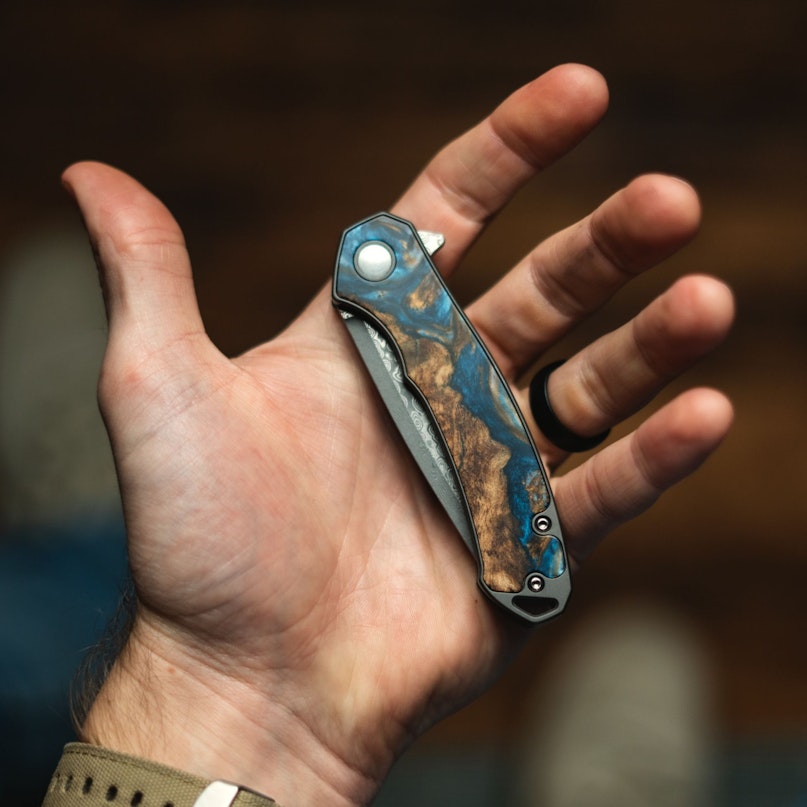
Have you ever heard of the EDC trend? No, it's not a music festival. EDC is a trend that stands for "everyday carry." Imagine being that person who's always ready for everyday tasks, no matter what life throws at you.
Did you forget to open that annoying plastic packaging? No worries.
Do you need to tighten a loose screw? Done!
An EDC knife is your perfect tool. We're talking quality—sleek, modern tools compact enough to fit snugly in your pocket but versatile enough to tackle a world of tasks.
Let's explore the world of EDC knives. We’ll look at their uses, why they’re so popular, how to pick the perfect one for you. And we’ll touch on the do's and don'ts of carrying an EDC knife, so you’ll stay on the right side of the law.
Key Features of an EDC Knife
Every EDC knife has its charm, but as knife enthusiasts know, some common features elevate it to everyday-carry royalty.
Compact Size & Lightweight Design
Your EDC knife should act as your shadow—it should follow you everywhere, being compact and lightweight. Think about a pocket knife you'll use for common tasks, often daily, that won't turn your pockets into a saggy mess.
EDC knives are easily portable, allowing you to carry them comfortably in your pocket, on a keychain, or in a small pouch with the rest of your everyday carry gear.
Blade Material & Sharpness
Quality matters. Top-notch EDC knives often use premium materials for crafting, like stainless steel, Damascus steel, and titanium. Why? They remain sharp, resist corrosion, and are built to last.
The blade plays a crucial role in its overall performance and utility. High-quality EDC knives use durable and corrosion-resistant materials such as stainless steel, carbon steel, or titanium—these materials keep the blade sharp and its edge durable for extended periods, even under regular use.
Additionally, the sharpness of the blade is another important factor to consider. A sharp blade gives precise and efficient cutting, which simplifies tasks like opening packages, cutting ropes, or preparing food.
Locking Mechanism
Safety first. Many EDC knives sport locking mechanisms. It's not just a fancy feature; it keeps the blade firmly in place, so you don't accidentally end up with a surprise nick or cut. It's important to choose a strong, high-quality knife with a superb design.
Common types of locking mechanisms include liner locks, frame locks, and lockbacks. These mechanisms ensure that the blade remains open and prevents accidental closures, reducing the risk of injuries.
When choosing an EDC knife, consider the locking mechanism that suits your preference and provides a reliable and secure hold during use.
Handle Material & Ergonomic Grip
The handle needs to feel good in your hand. From plastics to stainless steel and classy materials like titanium with wood + resin inlay, there's a handle for everyone. And it's not just about the look; ergonomic designs ensure your knife feels like an extension of your hand.

Common handle materials include plastics, fiberglass-reinforced nylon (FRN), G-10, stainless steel, as well as natural materials like bone and wood.
Ergonomics also plays a crucial role in the handle design. Look for EDC knives with contoured handles, finger grooves, or textured surfaces that provide a firm grip, even in wet or slippery conditions. A handle that is comfortable and ergonomic will improve your experience and make the knife easier to use.
By understanding and considering these key features of an EDC knife, you can select a knife that meets your specific needs and requirements.
Choosing the Right EDC Knife for You
Choosing your EDC knife is like dating. It's personal. Start by asking yourself: What am I going to use it for? Daily tasks? Outdoor adventures? The answer is: it depends.
1. Determine Your Needs & Preferences
Before delving into the different aspects of an EDC knife, it's important to determine your specific needs and preferences. Consider the following:
- What tasks do you expect to use the EDC knife for? Is it mainly for everyday tasks like opening packages or cutting ropes, or do you need a more durable knife for outdoor activities like camping or hiking?
- What size or weight do you find most comfortable to carry daily?
- What are your preferences for blade style, handle material, or locking mechanism? Or do you prefer a folding blade over a straight blade?
- What's your budget? EDC knives can range from affordable options to high-end models, so it's crucial to establish a budget that aligns with your financial considerations.
Understanding your needs and preferences clearly will streamline your options and facilitate the knife selection process.
2. Blade Style & Shape
ED knives come in different blade styles and shapes, each suited for specific purposes. Some common blade styles include:
- Drop Point: Versatile blade style with a curved edge and a strong, pointed tip, ideal for general-purpose tasks.
- Tanto: Strength-oriented blade with a straight edge and a reinforced tip, suitable for piercing and slicing tasks.
- Clip Point: Precision-focused blade with a concave cutout near the tip, offering excellent control for detailed cutting tasks.
- Wharncliffe: Straight-edge blade with a flat tip, excelling in precise and controlled cuts.
- Consider the tasks you anticipate using the EDC knife and select a blade style that aligns with those requirements.
3. Size & Weight
Size and weight matter and affect portability and comfort in your everyday carry.
You have options: small and compact with a 2-3 inch blade or larger models with 3.5-4 inch blades. Consider your comfort level and the legal restrictions in your area when picking the size.
EDC Knife Safety & Legal Considerations
All coolness aside, when using your EDC knife for common tasks, safety is paramount.
Safe Handling & Usage
Here are some safety guidelines to follow:
- Treat your knife with respect and handle it responsibly.
- Keep your fingers away from the blade, and never place your hand before the cutting edge.
- Use the appropriate cutting technique for the task at hand.
- Avoid using excessive force or applying pressure in a way that could cause the blade to snap shut unexpectedly.
- When closing the knife, keep your fingers clear of the blade path.
- Store the knife in a secure and safe place when not used.
Legal Restrictions
Legally speaking, knife laws about carrying knives can vary. Always know the rules of your state, city, or country. A little homework goes a long way—you want your EDC experience to be smooth sailing.
Here are some general considerations:
- When researching knife laws in your area, look for rules on blade length, locking mechanisms, concealed carry, and prohibited knives.
- Be aware of restrictions in schools, government buildings, amusement parks, theaters, airports, or other public areas.
- Research laws when traveling with your EDC knife to ensure compliance in each state.
- Carry your EDC knife responsibly and be prepared to explain its use if questioned by law enforcement.
To recap, the everyday carry scene is buzzing, and if you're not already, it's time to be part of the group. EDCs are more than trendy items; they're practical tools for daily tasks, beautiful, and a dream to carry.
So, what did we learn? Those who know that preparation is key know that pocket knives are essential—they're compact, versatile, and designed to be your daily companion. From understanding the standout features like blade quality and safety locks to knowing how to choose the perfect fit based on use, style, and comfort, we've delved deep. And, of course, the importance of safety and legality cannot be overstated. In essence, EDC knives are a testament to readiness.
Now it's your turn. Find your match so you can navigate life's twists with an edge.


